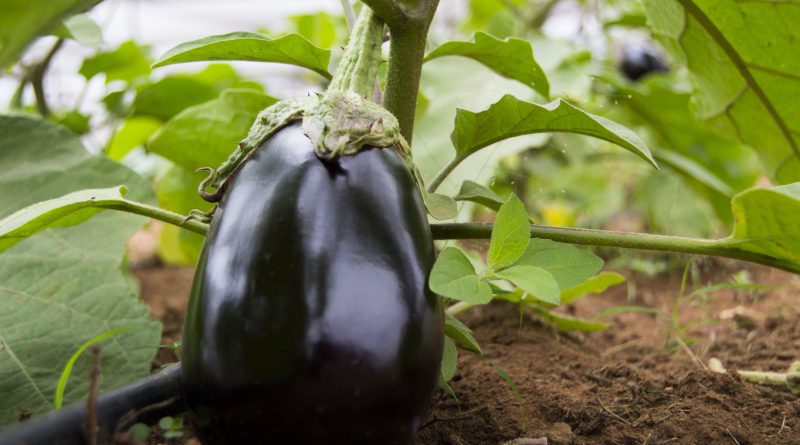Niche Farming: Eggplant Production in Kumakwane
Andrew Leppan, together with his family, own and manage Agriserv, a seedling production and agricultural consultancy, which is situated on the outskirts of Kumakwane and is one of the few suppliers of eggplant to the local supermarkets. He explains to Farmers Review why egg plant is such an easy crop to manage.
The eggplant has always been one of packages supplied by Agriserv when they were a full horticultural production farm. Andrew says that they initially tried various crops but the reason they chose the eggplant was because of its short shelf life, and that it doesn’t handle transportation from the farm to the market that well. Within few days of harvesting it loses the colour, the shinny look and it gets soft and wrinkled quickly and not which then makes it not marketable. That to the Leppans, was a major advantage for them over imports as they were located a few kilometres from their customers.
“We could supply it on a daily basis. Which allowed shops to get a decent shelf life before it goes bad.” Explains Andrew.
Eggplant comes in a variety of colours, sizes and different shapes. The choice of a variety by the farmer is dependent on the market. The European market generally prefers the tear drop shape. The Asian market prefers the long, thin eggplant that is almost 30cm in length and looks more like a cucumber. Then there is the Indian market which prefers a mixture of all of the varieties.
When it comes to production, there are two types, hybrid and the open pollinated. Open pollinated is more of a round shaped fruit and doesn’t have dark purple colour and is not very attractive. According to Andrew, customers don’t want to see seeds when they open the eggplant that’s why it’s not always advisable to use the open pollinated variety as the seeds mature very early.
“On our farm we selected the tear drop variety as it is slightly easier to grow. It is a bi-annual plant, meaning, it lasts for up to two years. Having said that, in my experience, production in the second year is not as good as the first one.” Elaborates Andrew. He goes on to say that despite the eggplant being a bi-annual crop, they planted every year and as such they were able to enter the market earlier than their competitors.
Andrew explains that since the eggplant is a summer crop, it does not take frost very well. He says that when the temperatures are extremely cold in it will die and that it doesn’t make any fruits in winter even if it’s not dead.
In terms of pests and diseases, the eggplant is a fairly hardy plant. It does get attacked by some pests and diseases but they are relatively easy to control. However, according to Andrew, the most devastating pest for the eggplant is be Red Spider mite.
Mr Leppan reckons that the eggplant can be a good, profitable crop for beginning farmers because of its easy of handling and abundance of fruit. Its input costs are very low, it is fairly heat tolerant, and it can relatively withstand very wet conditions. “So it basically doesn’t mind very dry or very wet conditions. Unlike some vegetables or fruits like a tomato whereby if it’s dry and suddenly gets very wet it will crack. Eggplant doesn’t do that.” Says Andrew. The eggplant also doesn’t get eaten by many birds or animals so farmers won’t get a lot of damaged fruit.
He however says that the biggest challenge for farmers will be the market if grown in large volumes. “Before you plant you need to determine the volume that your market can absorb and only plant enough for that.” He cautions. If a farmer plants large volumes he will end up with inventory that he cannot sell which will ultimately translate into loses.
According to Leppan, the Botswana market isn’t big enough for the eggplant to be the only crop that one produces. It can be an important part of a basket of crops that they produce. Having said that, Andrew explains that this doesn’t mean the market is so small that it is not economically viable for a number of farmers to grow. “The demand is enough for a farmer to grow a quarter or even half a hectare. But if one was to grow about two hectares he might end up with too much eggplant.” He says.
The eggplant’s nutritional requirement are not specific therefore it is a very efficient feeder. It can absorb a large percentage of available nutrients. “So it can virtually use all the nutrients that you put into the ground.” Says Andrew. He points out that other crops are from a completely different feeding category called gross feeding group. In this group, a crop like a cabbage which is a member, will use only 30% of the available nutrients meaning that from a 1kg of available nutrients, a cabbage only uses about 300g.
The plant itself has very big leaves, and according to Leppan, this provides shade to the fruit as well as cover to decrease loss of moisture. This is a major advantage as it means the farmer don’t necessarily have to plant the crop under the shade net.
Andrew says that the eggplant is even more profitable if using hybrids as they do not get spoilt quickly once they have reached the full ripe stage. The fruits can stay on the crop for quite a long time, up to four weeks, before they get damaged.
“This makes marketing a little bit easier as you don’t have the added pressure of having to harvest as the plant ripens. A lot of other crops such as tomatoes gets damaged quickly if a farmer doesn’t harvest them as they ripe.” He emphasizes.
When explaining where he sells his produce Leppan says that just about all of the local supermarkets sell eggplants and these include Choppies, Spar and Pick n Pay. Eggplant is consumed mostly by the Indian and Asian communities. “Our best customers are Mr Veg and Veggieland who are predominantly supplying the Indian and Asian markets.” Explains Andrew.
As for the menu, Mr Leppan explains that the eggplant has multiple uses, is healthy and that diabetics use it as a replacement for potatoes. He says that it goes very well with tomatoes and green pepper in a soup. It can also be used to make chips.
“I think it is one of those crops that are going to come more popular in the future as more and more people realise its benefits.” He concludes.



